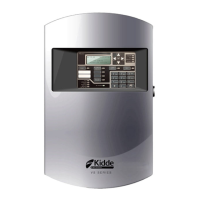Chapter 2: Front panel programming
52 P/N 3102351-EN • REV 005 • ISS 28DEC18
Description
Photoelectric smoke detectors (PS
/PD)
For smoke detectors and contact devices. All activations are immediately
considered as alarms. The panel and detector cannot be restored to normal until
the smoke condition has cleared and the control panel is reset.
For smoke detectors and contact devices. Two-wire smoke detector activations
are verified (delayed and confirmed) before activating an alarm. Four-
detectors and contact devices are not verified and immediately considered as
alarms. The panel and detector cannot be restored to normal until the smoke
condition has cleared and the panel is reset.
For detectors that trigger an active (supervisory) event. Detectors with this device
type remain active until the condition that activated them is restored and the
control panel is reset.
For detectors that trigger an active (supervisory) event. Detectors with this device
type remain active until the smoke condition has cleared. Resetting the control
panel is not required.
Photoelectric smoke heat detectors (PHS
/PHD)
For heat + smoke detectors that trigger an active alarm event (heat or smoke).
Detectors with this device type remain active until the condition that activated
them is restored and the control panel is reset.
Heat + supervisory smoke
latching
For heat + smoke detectors that trigger an active alarm event (heat) or a latching
supervisory event (smoke).
Detectors with this device type remain active until the condition that activated
them is restored and the control panel is reset.
Heat + supervisory smoke
nonlatching
For heat + smoke detectors that trigger an active alarm event (heat) or a
nonlatching supervisory event (smoke).
Detectors with this device type remain active until the condition that activated
them is restored. Resetting the control panel is required to restore the heat type
event. Resetting the control panel is not required for smoke supervisory
nonlatching.
Note: When the heat alarm and supervisory nonlatching are in an active state,
supervisory nonlatching will not automatically restore until the smoke particles
clear the chamber and the panel is reset.
For smoke detectors that trigger an active alarm event.
Detectors with this device type remain active until the condition that activated
them is restored and the control panel is reset.
For smoke detectors that trigger an alarm verify event first then trigger an active
alarm event only after confirming the alarm condition.
This feature is known as alarm verification and is typically used to prevent false
alarms in areas where transient smoke is anticipated.
For detectors that trigger an active supervisory event.
Detectors with this device type remain active until the condition that activated
them is restored and the control panel is reset.

